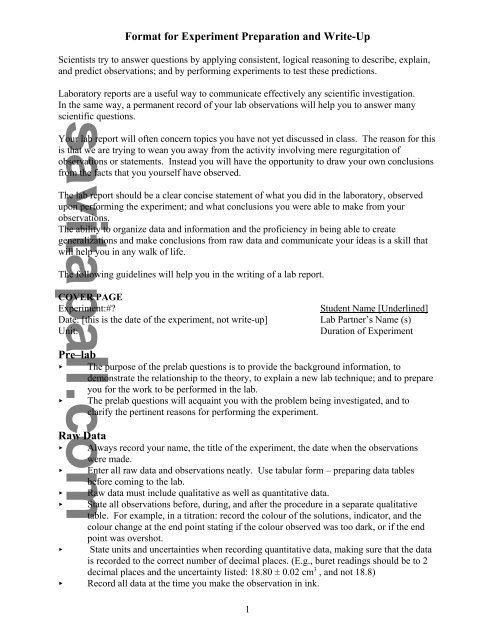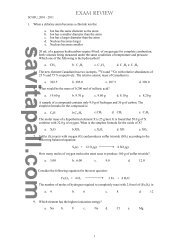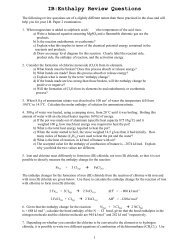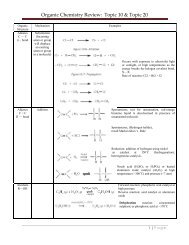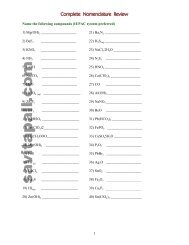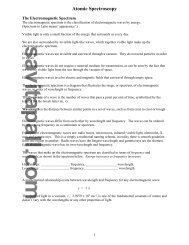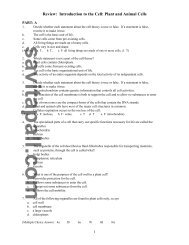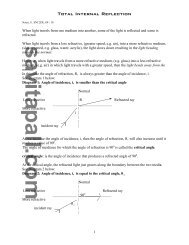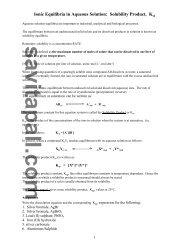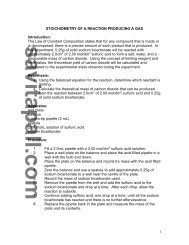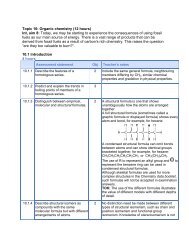Format Lab Write Up_08 - Savita Pall and Chemistry
Format Lab Write Up_08 - Savita Pall and Chemistry
Format Lab Write Up_08 - Savita Pall and Chemistry
Create successful ePaper yourself
Turn your PDF publications into a flip-book with our unique Google optimized e-Paper software.
<strong>Format</strong> for Experiment Preparation <strong>and</strong> <strong>Write</strong>-<strong>Up</strong><br />
Scientists try to answer questions by applying consistent, logical reasoning to describe, explain,<br />
<strong>and</strong> predict observations; <strong>and</strong> by performing experiments to test these predictions.<br />
<strong>Lab</strong>oratory reports are a useful way to communicate effectively any scientific investigation.<br />
In the same way, a permanent record of your lab observations will help you to answer many<br />
scientific questions.<br />
<br />
Your lab report will often concern topics you have not yet discussed in class. The reason for this<br />
is that we are trying to wean you away from the activity involving mere regurgitation of<br />
observations or statements. Instead you will have the opportunity to draw your own conclusions<br />
from the facts that you yourself have observed.<br />
The lab report should be a clear concise statement of what you did in the laboratory, observed<br />
upon performing the experiment; <strong>and</strong> what conclusions you were able to make from your<br />
observations.<br />
The ability to organize data <strong>and</strong> information <strong>and</strong> the proficiency in being able to create<br />
generalizations <strong>and</strong> make conclusions from raw data <strong>and</strong> communicate your ideas is a skill that<br />
will help you in any walk of life.<br />
The following guidelines will help you in the writing of a lab report.<br />
COVER PAGE<br />
Experiment:#?<br />
Date: [this is the date of the experiment, not write-up]<br />
Unit:<br />
Student Name [Underlined]<br />
<strong>Lab</strong> Partner’s Name (s)<br />
Duration of Experiment<br />
Pre–lab<br />
< The purpose of the prelab questions is to provide the background information, to<br />
demonstrate the relationship to the theory, to explain a new lab technique; <strong>and</strong> to prepare<br />
you for the work to be performed in the lab.<br />
< The prelab questions will acquaint you with the problem being investigated, <strong>and</strong> to<br />
clarify the pertinent reasons for performing the experiment.<br />
Raw Data<br />
< Always record your name, the title of the experiment, the date when the observations<br />
were made.<br />
< Enter all raw data <strong>and</strong> observations neatly. Use tabular form – preparing data tables<br />
before coming to the lab.<br />
< Raw data must include qualitative as well as quantitative data.<br />
< State all observations before, during, <strong>and</strong> after the procedure in a separate qualitative<br />
table. For example, in a titration: record the colour of the solutions, indicator, <strong>and</strong> the<br />
colour change at the end point stating if the colour observed was too dark, or if the end<br />
point was overshot.<br />
< State units <strong>and</strong> uncertainties when recording quantitative data, making sure that the data<br />
is recorded to the correct number of decimal places. (E.g., buret readings should be to 2<br />
decimal places <strong>and</strong> the uncertainty listed: 18.80 ± 0.02 cm 3 , <strong>and</strong> not 18.8)<br />
< Record all data at the time you make the observation in ink.<br />
1
Data are never made on scrap paper.<br />
< An error in data is corrected by putting a single line through it, <strong>and</strong> re-writing the<br />
corrected number near–by. The original wrong number must be legible. White–out must<br />
never be used on data.<br />
< Raw data must be clearly presented, allowing for easy interpretation.<br />
< Raw data should not be recopied !!!<br />
Research Question<br />
< This should be expressed as a question <strong>and</strong> you must be able to define the aim of the<br />
experiment or to identify a focused research question.<br />
< This is one or more statements describing the investigation. Stated in a list if more than<br />
one objective exists:<br />
1.<br />
2.<br />
3.<br />
< Although the purpose of the experiment is usually provided, however you will be<br />
expected to identify the purpose of the experiment before, during <strong>and</strong> after the lab work<br />
has been performed.<br />
<br />
Hypothesis<br />
< The hypothesis is your prediction <strong>and</strong> should be formulated to be an answer to the<br />
research question <strong>and</strong> should explain the rational used to state the prediction, i.e. using<br />
theory for your hypothesis.<br />
< The hypothesis should relate directly to the research question.<br />
< It should be specific <strong>and</strong> quantitative.<br />
< This should express a possible relationship between two or more variables, e.g. “If .....<br />
(manipulated variable)..... is done, then ..... (responding variable) ...... will occur ......<br />
because ..... (reasoning) ......”.<br />
< The hypothesis to the research question may also be explained in terms of a scientific<br />
concept (for example, a theory, law, or generalization), or another authority (for example,<br />
a reference source, or a label on a bottle).<br />
< Qualitative <strong>and</strong> quantitative reasoning should be included in the hypothesis.<br />
< Note that your hypothesis does not need to be correct, i.e. your investigation might prove<br />
it incorrect.<br />
Variables<br />
< State the main variables explicitly <strong>and</strong> explain why each is relevant to this investigation.<br />
< State which variables are independent <strong>and</strong> which are dependent (manipulated <strong>and</strong><br />
responding).<br />
< Indicate which variables need to be controlled<br />
< Manipulated variable: is the factor that you, the experimenter, investigate or change in a<br />
systematic manner during the experiment.<br />
< Responding variable: is the result or change that occurs because of the manipulated<br />
variable.<br />
< Controlled variable: those other factors which must be held constant so that they do not<br />
affect the responding variables.<br />
2
Apparatus <strong>and</strong> Materials<br />
< These are reported as separate vertical columns.<br />
< State a complete list of all equipment <strong>and</strong> chemicals including sizes <strong>and</strong> quantities.<br />
< List all major pieces of apparatus in detail (i.e. specific: 100 cm 3 beaker instead of simply<br />
stating “beaker”, e.g. thermometer, –10 O C to 110 O C range, 0.2 O C graduations).<br />
< When more complex equipment configurations are required, a diagram of the apparatus<br />
set up is included at this point.<br />
Method /Procedure<br />
< Usually this reads as “refer to resource lab sheet please”.<br />
< If the students design their own labs (as is the case several times in the year) the<br />
procedures are then stated by the student here.<br />
< Design a method which collects sufficient <strong>and</strong> relevant data for the variables under<br />
investigation <strong>and</strong> controls the other variables.<br />
< The procedure is detailed set of numbered, in vertical columns, with one set of instruction<br />
per step in the correct sequence (i.e. in the order you would do them in the investigation).<br />
< Provide sufficient details so that another person could repeat your work.<br />
< Your procedure should allow collection of sufficient relevant data.<br />
< The final step may include a statement of any safety precautions <strong>and</strong> waste disposals<br />
specific to the procedure.<br />
< The design of the experiment may be concept maps or flow charts of simple apparatus<br />
diagrams which are numbered to indicate order or sequence. Creativity is encouraged,<br />
without loss of clarity to convey information to the reader for purposes of “lab<br />
reproducibility”.<br />
< If a diagram is used to show the arrangement of the apparatus, then it should be a large<br />
clearly labelled diagram.<br />
< State any assumptions that are valid in the method chosen for the experiment.<br />
< Note that lab design is different from a <strong>Lab</strong> Report where you would describe the method<br />
in paragraph form <strong>and</strong> in past tense.<br />
<br />
Data Collection / Observations<br />
< The observations include all qualitative <strong>and</strong> quantitative observations relevant to<br />
answering the research question.<br />
< Organize your observations in tables, (number tables in Roman numerals).<br />
< Use of tables makes observations well-organized <strong>and</strong> thus easier to interpret.<br />
< Give an identifying title to each table.<br />
< The contents of the column should include: quantity, unit, <strong>and</strong> uncertainty.<br />
(This means that the units do not have to be included in the individual cells.)<br />
< Arrange entries so that they follow logically. This may be different from the order in<br />
which the data are observed, (‘mass of beaker + mass of water’, followed by ‘mass of<br />
beaker’).<br />
< Raw data: See above<br />
3
Data Processing / Data Analysis <strong>and</strong> Presentation<br />
< Data analysis includes calculations <strong>and</strong> interpretations based on the observations.<br />
< Calculation of results, do one sample calculation, identical calculations do not need to be<br />
repeated.<br />
< Show all steps clearly, using significant figures appropriately.<br />
< Keep one extra significant figure throughout a calculation to reduce rounding errors, the<br />
final result should be consistent with the number of significant figures in the<br />
experimental measurements.<br />
< For repeated trials, calculate a final result for each trial; do not use an average of raw<br />
data.<br />
< Calculate an average result, based on final results of repeated trials.<br />
< Any assumptions made in the experiment should be stated.<br />
< Do not forget to include balanced chemical equations.<br />
< Once the data analysis has been completed, the results should be presented so that they<br />
are easy to follow <strong>and</strong> underst<strong>and</strong>.<br />
< The results may be presented in a summary table.<br />
< Graphs may be useful, especially for several values of continuous variables: show title<br />
<strong>and</strong> axes, using st<strong>and</strong>ard notation, using an appropriate size (larger, rather than smaller),<br />
using an appropriate scale (the origin may not need to be included, indicating points<br />
clearly, <strong>and</strong> showing relationship by fitting points to line(s) or a smooth curve. [<strong>Lab</strong>el the<br />
manipulated variable on the x-axis, <strong>and</strong> the responding variable on the y-axis.]<br />
< Conclude the analysis with a statement of your experimental answer to the research<br />
question, including a phrase such as, “according to the observations obtained in this<br />
experiment, ...... ....(answer).....”).<br />
<br />
Conclusion <strong>and</strong> Evaluation<br />
< This section should answer the question in the problem by summarizing the observations<br />
<strong>and</strong> / or inferences <strong>and</strong> indicating whether or not the original prediction was correct.<br />
< In addition the conclusion should state whether the results of the experiment support or<br />
refute the reasoning in the hypothesis.<br />
< Compare with literature or accepted value or reasonable value where possible.<br />
< Calculate percent error where possible.<br />
< Limitations to conclusions should be clearly stated, i.e. are tests conclusive, are<br />
interpretations possible?<br />
Experimental Errors:<br />
Discuss the sources of errors in the observations made arising from limitations of the measuring<br />
instruments, limitations of the experimental procedure <strong>and</strong> skill of the experimenter.<br />
The evaluation includes your judgement of the procedure, i.e. the limitations of the procedures.<br />
For identified weaknesses, suggest improvements: suggestions should be realistic, not involving<br />
unavailable equipment or materials, suggestions should be specific, not vague (e.g. “More<br />
careful work”). Purposed changes should try to eliminate or reduce errors, improve control of<br />
variables, provide other procedures for better measurements.<br />
4
<strong>Write</strong> your evaluation in paragraph form, using the topic sentences suggested below, or similar<br />
to them. Show as much independent, critical, <strong>and</strong> creative thought as possible in support of your<br />
judgement.<br />
1. “The experimental design [name it] is judged to be adequate / in adequate because ....”<br />
Were you able to answer the problem/the research question using the chosen<br />
experimental design?<br />
Are there any obvious flaws in the design?<br />
what alternative designs [better or worse] are available?<br />
<br />
2. “The procedure is judged to be adequate / inadequate because....”<br />
Were the steps you used in the laboratory correctly sequenced, <strong>and</strong> adequate to gather<br />
sufficient evidence?<br />
What improvements could be made to the procedure?<br />
What, steps, if not done correctly, would have significantly affected the results?<br />
3. “The technological skills are judged to be adequate/inadequate because....”<br />
Which skills could you could you improve on that would have the greatest effect on the<br />
experimental results.<br />
Was the evidence from repeated trials similar?<br />
4. “The percent difference between the experimental result <strong>and</strong> the predicted value is ....”<br />
How does this difference compare with your estimated total uncertainty?<br />
5. “The prediction is judged to be verified/inconclusive because ...”<br />
How confident do you feel about your conclusion?<br />
These helpful hints will help you to successfully write a formal lab report.<br />
5


